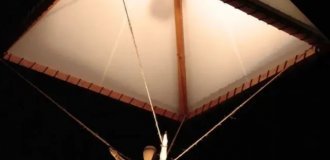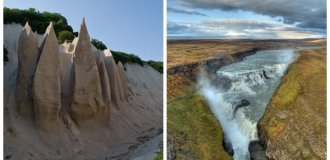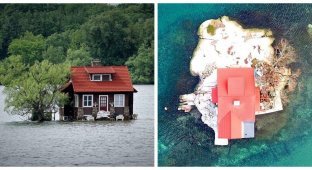7 tiny islands where people have ever lived (8 photos)
One of the islands of the Halligen group (Denmark). This cute island is not the smallest in this collection! 
A small island in the middle of the ocean is the embodiment of an introvert’s dream of peace and quiet. And such islands exist in reality.
Moreover, many of them are inhabited or become a center of attraction for tourists and exotic lovers. We present to you the seven islands where people live.
Not all of them are in the ocean, for example, like the first of the heroes of our selection:
Thousand Islands Archipelago (USA and Canada)
The highlight of the archipelago on the St. Lawrence River is a miniature piece of land called “Just Enough Space.” Its area is only 310 sq.m. 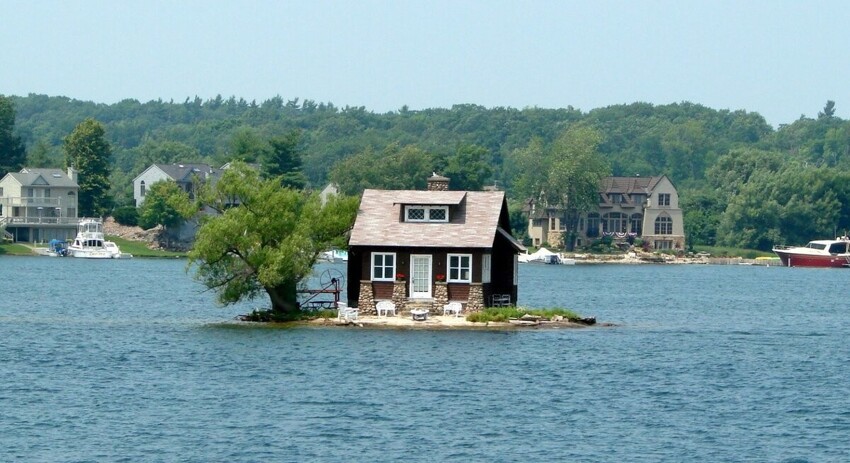
The island is owned by the Sizeland family. The head of the family bought the rights to it in the 50s of the last century and built a small house for a secluded vacation. In addition to the stone structure, there are a couple of trees and a small beach. The family spends weekends on their private island or celebrates holidays, drinking beer and roasting barbecue sausages.
Dunbar (Honduras)
The mini-island belongs to the Bay Islands group of islands, located in the Caribbean Sea, 70 km from the coast of Honduras. On a coral reef with an area of 490 sq.m. A luxurious snow-white villa was built. 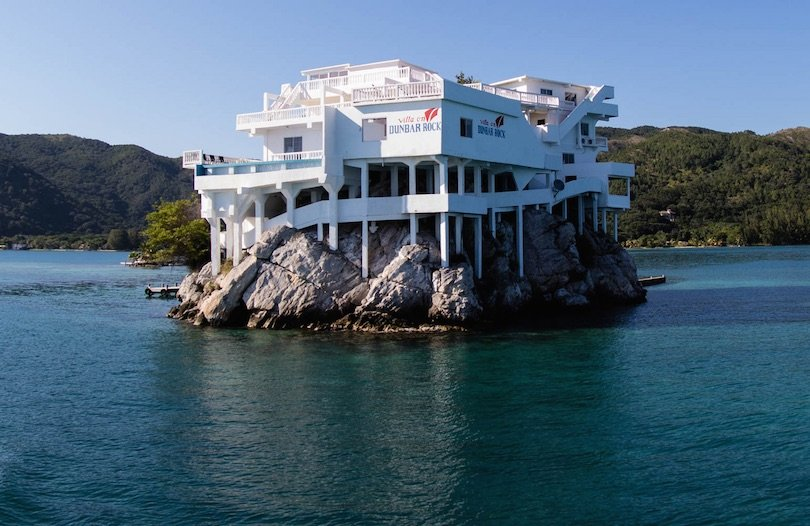
Due to the complex terrain of the rock, the building took more than 3 years to construct. The owner of the island laid communications to the house along the ocean floor, equipped a pier, and a convenient descent to the water. On the second level he created an outdoor swimming pool and opened a hotel. The private hotel is surrounded by a picturesque oak forest; gazebos are installed in the coastal area.
This place has become a center of attraction for diving and fishing enthusiasts. Tourists are also attracted by the mysterious legend about the treasures of the pirate Blackbeard. According to legend, the treasure of the famous filibuster is hidden in one of the local caves.
Little Brewster (USA)
A small rocky island with an area of less than 1000 sq.m. is located 14 km from Boston. This is the only corner of the land where there remains a lighthouse under human supervision. All other structures that light the way for sea vessels have long been automated. 
The beautiful lighthouse, called the Boston Light, is maintained by keeper Sally Slowman. This is the only woman who was entrusted with such a responsible position.
The lighthouse keeper spends many months alone on the island; supplies and everything she needs are delivered to her from the “mainland” by boat. There is no television or internet on the island, but this site is accessible for visits. Tourists come on excursions, and Sally’s husband, who lives with her on this uncomfortable patch of land for several months a year, does not leave her.
Wilhelmstein (Germany)
The man-made island appeared on Lake Steinhunder Meer in the 18th century. Duke Wilhelm of Schaumburg planned to create a powerful fortification to protect his possessions. For 5 years, the local population delivered sand, gravel and stones by boat to the construction site. In winter, construction materials were transported across the frozen lake. 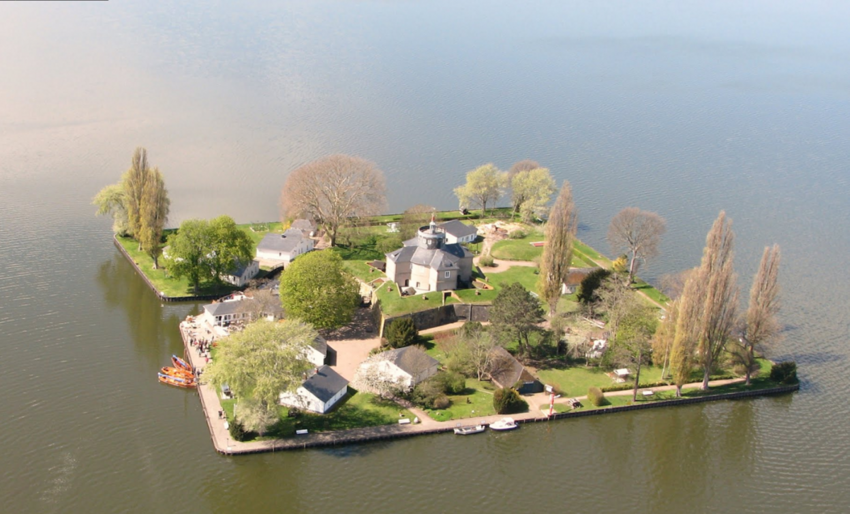
In the center of the bulk island they erected a stone fortress in the shape of a star with four rays. Serving in the fort was an ordeal for the soldiers. Due to the high humidity, many of them suffered from rheumatism and colds. In 1767, a military school for officer cadets was opened here. Later, after the death of the Duke, the fortress turned into a state prison.
Wilhelmstein is an example of German pedantry and accuracy. The island has the shape of a regular square, each side of which is 100 m. Now, in addition to the fortress, surrounded by centuries-old trees, the island has a museum, a hotel for tourists, a cafe and a souvenir shop. The island is still owned by the Duke's descendants, who have turned it into a lucrative tourist attraction.
Bled Island (Slovenia)
When looking at Lake Bled, located in the foothills of the Alps, a fabulous picture opens up. In the middle of a reservoir with clear turquoise water rises a green island, shaped like a gondola.
A small plot of land with an area of 0.82 hectares accommodates the Mariinsky Church, medieval houses with red tiled roofs, an archeology museum, a cozy cafe and souvenir shops. The oldest part is Bled Castle and its 50 m high Romanesque tower. 
This island is a tourist attraction and a visiting map of Slovenia. A wonderful wedding tradition is maintained here - couples wishing to get married must climb 99 steps leading to the church. The groom must carry the bride in his arms all the way. This path is considered the key to a happy married life.
“Mouse Island” – Pontikonisi (Greece)
Pontikonisi Island is called “mouse island” because of its modest size - no more than 1 hectare (the previous heroes of our selection can then be safely called slipper ciliates, because against their background Mouse Island is a real giant).
This cozy, green corner in the Mediterranean Sea is a historical landmark. Here is the Pantocrator, a Byzantine chapel dating from the 11th-12th centuries. Monks have always loved solitude, and the island is an ideal option. 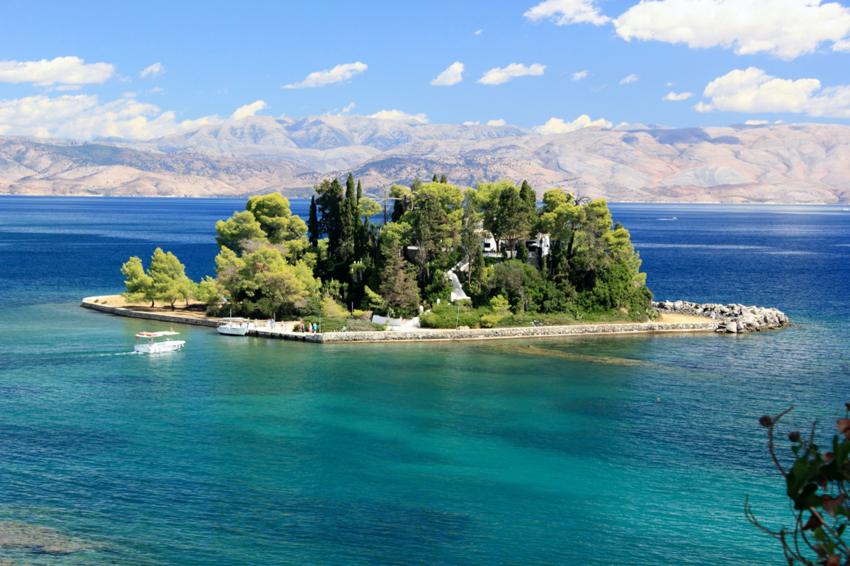
From here you can enjoy picturesque views of the sea, Greek villages and the small monastery of Blachernae, which is connected to the island by a narrow bridge. It is in this monastery that world-famous icons of Byzantine writing are created.
Pitcairn Island (UK) 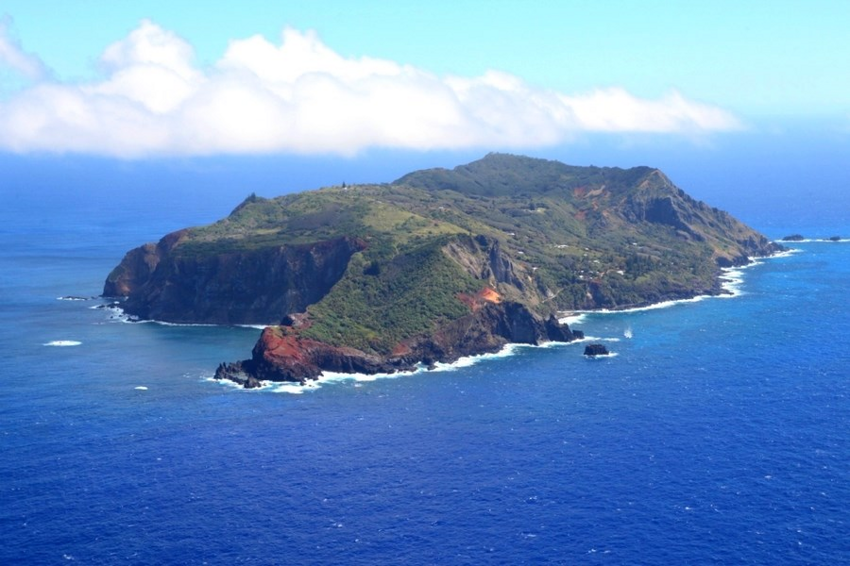
A small piece of land less than 2 miles in area is located in the South Pacific Ocean. Tourists began to visit this inaccessible volcanic island with rich tropical flora and fauna only with the opening of the Panama Canal.
Pitcairn has a population of 49 people. All of them are descendants of the mutineers from the British ship "Bounty".
In 1789, rebels seized power on the Bounty. They put the captain on a boat (and he, having sailed 6 thousand kilometers, told the authorities about the mutiny).
Some of the rebels decided to settle on the island of Pitcairn. The decision turned out to be wise. Because the main group of rebels settled in Tahiti, where they were subsequently arrested by the British authorities.
And the sailors on Pitcairn were discovered only 40 years later. And they no longer brought any claims against them due to the expiration of the statute of limitations. It is surprising that the sailors were not only able to survive, but even acquired offspring by marrying local Tahitian women.
Cruise ships call at Pitcairn only 4 times a year. The parking lasts several hours. This is enough time to see the sights and chat with the locals.
Of the island's small population, only a third are able to work, so the government tried to attract new residents to Pitcairn through a special program. However, there were no people willing to move to a permanent place of residence in this corner remote from civilization.



